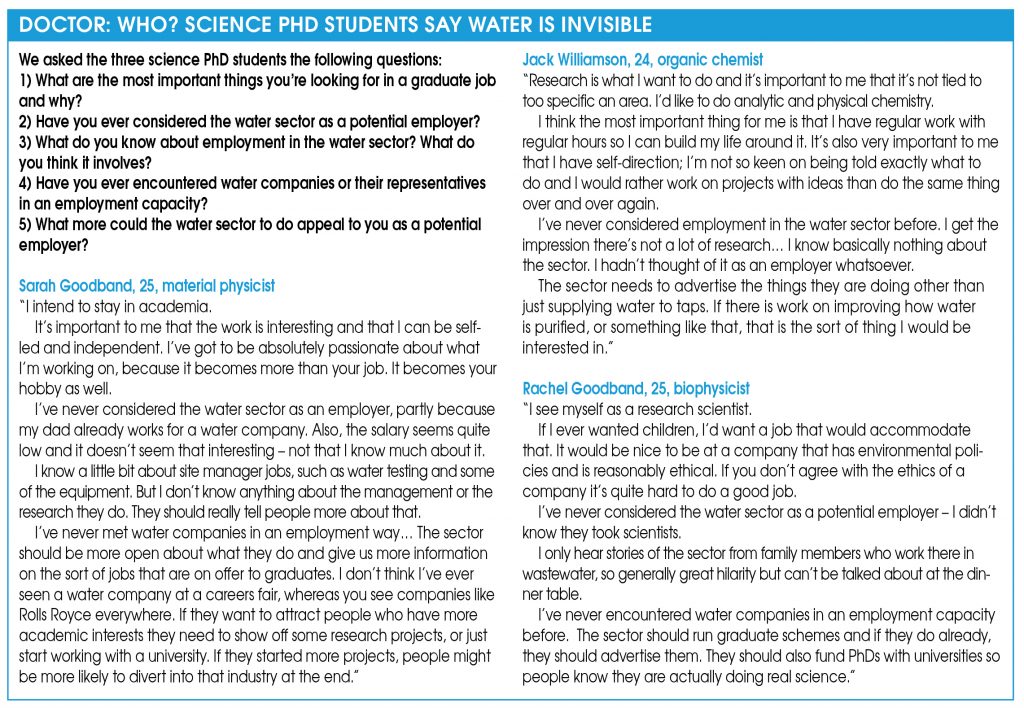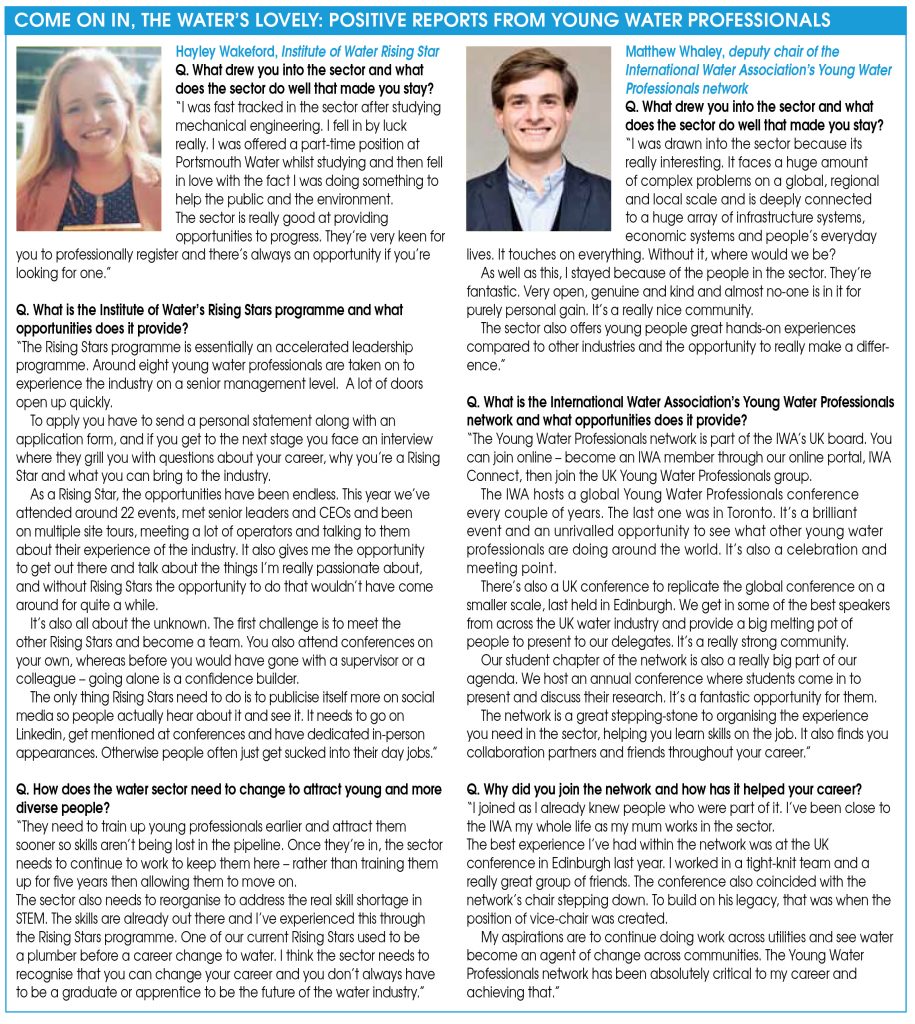Published on: December 20, 2019 at 9:46 AM
When we asked a handful of science PhD students if they had ever considered the water sector as a potential employer, we were met with a re-sounding ‘no’. None of them had encountered the sector in a recruitment capacity or given it as much as a fleeting thought.
The Water Report’s rough and ready research among PhD students (see box) suggests the sector has much to do to entice younger workers into water, and that resonates with much broader research and analysis of the sector. The water industry has ongoing problems with attracting new professionals, retaining them and more broadly with a lack of diversity in the work-force – including its age profile. It needs to attract younger and more diverse people and then keep them once they’re in.
I don’t think I’ve ever seen a water company at a careers fair, whereas you see companies like Rolls Royce everywhere.
We spoke to people on several sides of this issue – workforce experts, association representatives, young water professionals and PhD students soon looking for work – to find out what needs to be done to improve the situation.
Strength in diversity
Nick Ellins, chief executive of workforce specialist Energy and Utility Skills, framed discussions by giving an overview of the typically older age profile in the sector and why this needs to change. “It just has to happen,” Ellins says. “Simple science says if you want to run a better business you need to get a better mix of people. It’s financially proven that more diverse workforces outperform others. Every sin-gle organisation is serving a diverse community and there needs to be contact points between the sector and the community.”
Trevor Bishop, speaking on behalf of the International Water Association (IWA), echoes these concerns. “The way we’re doing things now simply will fail unless we radically change.” The sector, he adds, has “a long way to go”.
Carly Perry, senior manager of the energy and utilities team at management consultant Sia Partners, focuses on workforce resilience. “We’re all aware that the water sector has an ageing work-force. It’s critical we encourage a next generation of professionals to tackle the sector’s challenges. But at the moment, we don’t have a pipeline of young people with the skills we need. Utilities need to start asking questions about what skills are needed for the ambitions of the future.”
Ellins observes how empowerment of young professionals and more diverse recruitment is also a critical part of the solution to big challenges facing the sector. “The only way to get better is to increase the amount of perspectives you get on one problem.” When asked what the biggest challenge facing water professionals of the future is, he responds: “The changing climate. That’s got to be it. It’s every single challenge the water industry faces.” He adds: “There’s a whole series of intellectual challenges. Vast amounts of investment is needed for infrastructure to be fit for the future – but this money comes from customers who aren’t prepared to pay more.”
Similarly, Bishop highlights why the IWA is keen to foster communities of young water professionals in terms of legacy. “A lot of us are not happy with the legacy left for the next generation. Enabling communities of young water professionals gives them a head-start in laying the groundwork to face issues we have not.” Bishop mirrors Ellins’ concerns about the environment but was keen not to underplay other challenges such as water quality, sustainability and supply capacity given population growth. He sums up: “It is not just the right thing to do, the need has never been greater.”

Simple science says if you want to run a better business you need to get a better mix of people.
Stars, networks and dragons
Some of the initiatives already in place to address this include the Institute of Water’s (IoW) Rising Stars programme, the IWA’s young water professionals network and Energy and Utility Skills’ Partner-ship Inclusion Commitment. The Inclusion Commitment aims to attract and recruit more diverse talent into the sector via inclusivity-lead action through a partnership across sectors. Ellins explains: “Twenty-eight CEOs on a council get together a couple of times a year to set a strategy for the future workforce needed and how to be fully inclusive. All water and gas companies have signed up, and about 70% of the power industry.”
Ellins is also keen to highlight the IoW’s Rising Stars programme and the opportunities it presents to young water professionals. In the programme, companies nominate their exceptional young professionals to be a ‘rising star’ and a group of ten get selected. “The idea of Rising Stars is to give young profes-sionals opportunities early in their career. It’s deliberately set up to make them feel special. Anything you can think of where you would think ‘well, you wouldn’t normally get to do that until you’re a director’, we wanted to change so they can get that experience in the first few years of their career.”
Ellins also speaks highly of other young professional programmes running elsewhere, such as the Future Water Association’s Young Water Dragons: “Future Water has a programme where young professionals get to pitch products on behalf of their businesses to old crusties like me. This is so they can get right in at the deep end with the top people in procurement and CEOs, and so their talent can be spotted.” Ellins points too to the IWA’s Young Water Professionals Net-work, which works closely with the IoW’s Rising Stars and broadly with young professionals in both associations. The net-work looks to invest in young people in the water sector, with both local chapters and international conferences. Bishop clarifies: “What is important to remember is they do this themselves – it’s not laid on for them, they have to drive this organisation. They have their own chairs and organise events on their own.”
However, Bishop thinks the network should be empowered to do more, and the next stage is to get young professionals more involved with decision-making. “We’re currently toying with the idea of having a shadow board of young water professionals to our senior board. But the big challenge there is that we can’t have all the young professionals on it – so we’ve got to figure out how to make it equitable.”
Strategic planning for recruitment
Sia’s Perry praises these initiatives but notes that “it feels like currently momentum is coming from associations, with activity from water companies being less visible. I also haven’t yet seen a robust workforce plan that covers both supply and demand angles in water companies. There are most definitely lessons that we can be learning from other sectors and the question is: what can water companies be doing to better plan their future workforce?”
People are key to change and that means shifting some focus to ensure your workforce skills match the challenges ahead.
Some water companies do have initiatives targeted at empowering their young people, such as Portsmouth Water’s Young Persons Board. But in the round, Perry argues the sector needs to do more effective workforce planning, centring around the supply and demand of skills. She points to the rail sector and government defence teams as good examples of both manual and automated planning.
“Rail are putting more effort into understanding the relationship between roles and skills so they can identify gaps and overlaps. This enables them to upskill people and facilitate better workforce retention.”
She gives the example of automated workforce planning in a government defence team working on international large-scale vehicle construction. “They wanted to understand supply and demand so they looked at the skills they needed over a multiple year project and visualised their needs in terms of role profiles and locations. A consolidation of HR and public data points on skills available in the market can then be put into an automated tool to stress test your options and identify your strongest scenario.”
It is this kind of holistic workforce planning Perry believes the water sector could learn from. She says ‘good’ looks like “HR teams working with strategic leaders across the business to un-derstand what skills are needed to deliver the ambitious AMP7 plans and then mapping that view to the skills available in the market. This highlights the gaps and gives a focus for generating a stronger pipeline of talent.”
Perry stresses this level of workforce planning is especially crucial for a sector with much change on the horizon, citing the seasonability of asset challenges, technology advances and regulatory requirements: “People are key to change and that means shifting some focus to ensure your workforce skills match the challenges ahead.” She sums up the sector’s need to change with this example: “Physical assets have historically been viewed as the critical assets, but actually success relies on those managing those assets. How companies respond to the ageing workforce challenge is going to become increasingly more important.”

A better story
Ellins similarly speaks about the sector’s need to change the way it does recruitment and to root out unintended bias: “Engineer-ing jobs are typically advertised in a way that either block females from joining, or once they join, it’s not the job they thought it was. For example, a job in leakage is advertised as scientific but is actually at night, in the dark, wet, involves heavy lifting, no loo etc. And that’s where retention issues come in.” Ellins also points to the severe lack of diversity in apprenticeships and how part of the battle for inclusivity includes “changing boards high up to change patterns of thinking.” He asserts that structures of pay, reward and working conditions all need review to promote diverse people aiming for top jobs: “For example, working moth-ers in senior teams need to know that they don’t need to work all hours God sends just to do the job.”
It is clear that the sector needs to change to attract young, diverse new employees and the time to act is now. Bishop sums up much of the industry’s problem: “There’s so many amazing things in the sector and it’s hard for me to see where you can have a career with more social impact. The single big issue is: how do we tell the story? It is not the natural talent of utilities to tell a strong story.”
Telling water’s significant story to the wider public is a key hurdle to entice new talent to the industry, as well as being crucial to many other challenges facing the sector.
This article has been reproduced with the kind permission of The Water Report (www.thewaterreport.co.uk).
